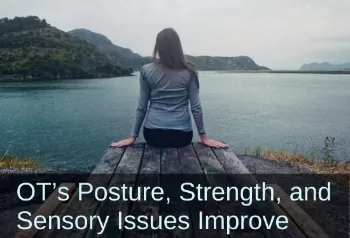Primitive Reflex Integration Case Studies
Pediatric Therapist: “Happy with Results and Very Excited about This Course”
Submitted by By Nevanka St Clair, Occupational Therapist

| Before | After |
|---|---|
| Lordosis of spine | Posture is better and less lordotic |
| Weak core | Better able to feel and activate core more easily |
| Sensitive to light touch | Less sensitive to light touch |
| Loud constant noise caused stress | More able to tolerate loud noises |
Name: Nevanka Age: 38
Challenges:
- Lordosis of spine
- Weak core
- Difficulties learning to read and spell at school
- Motion sickness
- Difficulties with eye tracking and focusing on the correct position on a page
- Sensitive to light touch
- Loud constant noise stresses me
Movement Program:
When completing the assessment of reflexes, I noted that most of the reflexes taught in the Brain and Sensory Foundations course are unintegrated for me to a greater and lesser extent aside from the Spinal Galant and the Head Righting Reflex. This was interesting to me as when I was 16 I completed Extra Lesson which also uses techniques to help integrate reflexes however not in such as specific way as this course does. At the time this had a profound effect on my learning and my grades in school. However, this course has made me realize that I still have more work to do, or perhaps traumatic events since that time has meant that I now need to re integrate these reflexes.
To begin with I started the Rhythmical Movements [from the Brain and Sensory Foundations course] and worked hard to complete these most days. Not long after I slipped a disc in my lower back and everything stopped for a period of approximately 3 months or so. When starting back up again more recently I have started working on integrating the TLR [Tonic Labyrinthine Reflex] and as well as the hand and feet reflexes. I have also worked on the ATNR [Asymmetrical Tonic Neck Reflex]. Recently when activating the [TLR] I no longer feel nauseous and I can now close my eyes when activating the reflex. Moving forward I will begin to work on the Fear Paralysis Reflex, Moro [reflex] and STNR [Symmetrical Tonic Neck Reflex].
I completed a 5-Step Balance Process [from the Brain and Sensory Foundations course] for myself on the frustration of not being about to get my children to participate in the rhythmical movements and reflex Integration. After completing this I then realized that I was not doing Heart Connection and that the whole process had become a chore for all of us rather than a joy. I then worked on making sure I was in heart connection and that the movements where fun and loving and playful. This made all the difference and my children are now happy to participate in the movements.
Changes noticed:
I have noticed that my posture is better and less lordotic and am able to feel and activate my core more easily—even after teaching Pilates for a couple of years! I feel like I am less sensitive to light touch and that I am more able to tolerate loud noises. I feel like there is still more work to be done but I am very happy with the results so far and very excited about this course.
I am a pediatric OT and am really enjoying incorporating all these great tools into my therapy sessions and seeing the results with my clients.
(Edited, emphasis added)
*Disclaimer: The activities in the Brain and Sensory Foundations curriculum make use of the natural processes of neuroplasticity and development that are innately wired in the design of human beings to promote maturity and function. These activities appear to calm, organize, and mature the neuro-sensory-motor systems just as we see in the healthy development of human infants. Individual results may vary, and we do not claim to offer a diagnosis or cure for any specific condition or disorder. The Brain and Sensory Foundations activities appear to improve overall functioning resulting in measurable improvements for a range of conditions as demonstrated in over 1800 case studies from participants.

